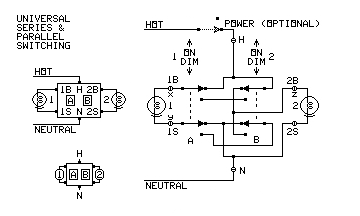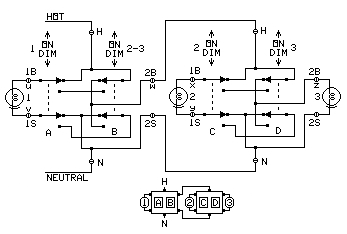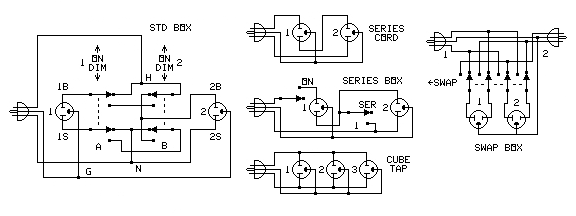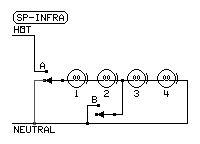RULES FOR LINE VOLTAGE SERIES-PARALLEL CIRCUITS- The power to the entire unit must be turned off before any bulbs are changed. - If the lamps are connected by cords and plugs, all of them must always be plugged in. - If lamps must be unplugged, plug in dummy loads to load the circuit. - If there are switches on the lampholders, they must never be turned off. Failure to obey these rules can possibly expose someone changing a bulb to lethal voltage. BEST USE OF LINE VOLTAGE SERIES-PARALLEL CIRCUITS- The switch positions on the STD units are intuitive:
- The wattages of the bulbs should be the same, so all bulbs in series are the same brightness. - If STD units are cascaded, the tree form is better than the linear cascade if quick dimming is needed. - If STD units are cascaded, the linear form is better than the tree cascade if some favored-lamp series-parallel switchings are needed. - If STD units are cascaded in tree form and the same number of lamps is on each side of the tree, then the switches on the top-level unit can be used to quickly dim all of them. This also helps even out wattage differences if the wattages are not all identical. - The SWAP BOX can't swap the power feed to any specific device with a device that gets power from that specific device. |
KEY TO TABLE ENTRIESON
DIM
Glim
off
−
*
†
Letters indicate closed switches. No letter for a switch, or an o for a switch, means the switch is open, or is in the unlabeled position. |
-
SEPAR 203 and SEPAR 204 (A circuit the page author built in 1984 and modified in 2004)

SWITCH LAMP A B C 1 2 o o off off † o B DIM DIM † o C off ON A o ON off A B ON off A C ON ON † This Series-Parallel Switching Circuit was originally built to put two electric fans in series or parallel, or to turn on either fan alone, for ventilation speed control. All possible combinations of series and parallel are possible, including off. Notice how one load can be connected to the live phase without any ground connection. This circuit is not safe for line voltage use.
A later version of this series-parallel switching circuit (SEPAR 204) was built to conform to the requirements of line voltage circuits. The switch positions are exactly the same, but the live connections are removed if the neutral side is opened.
Note that any switch position with a letter on it is the position indicated by that letter in the table.
|
|
|||||||||||||||||||||||||||||||||||||||||||||||||||||||||||||||||||||||||||||||||||||||||||||||||||||||||||||||||||||||||||||||||||||||||||||||||||||||||||||||||||||||||
|
|||||||||||||||||||||||||||||||||||||||||||||||||||||||||||||||||||||||||||||||||||||||||||||||||||||||||||||||||||||||||||||||||||||||||||||||||||||||||||||||||||||||||||||||||||||||||||||||||||||||||||||||||||||||||||||||||||||||||||||||||||||||||||||||||||||||||||||||||||||||||||||||||||||||||||||||||||||||||||||||||||||||||||||||||||||||||||||||||||||||||||||||||||||||||||||||||||||||||||||||||||||||||||||||||||||||||||||||||||||||||||||||||||||||||||||||||||||||||||||||||||||||||||||||||||||||||||||||||||||||||||||||||||||||||||||||||||||||||||||
|
|||||||||||||||||||||||||||||||||||||||||||||||||||||||||||||||||||||||||||||||||||||||||||||||||||||||||||||||||||||||||||||||||||||||||||||||||||||||
|
|
||||||||||||||||||||||||||||||






